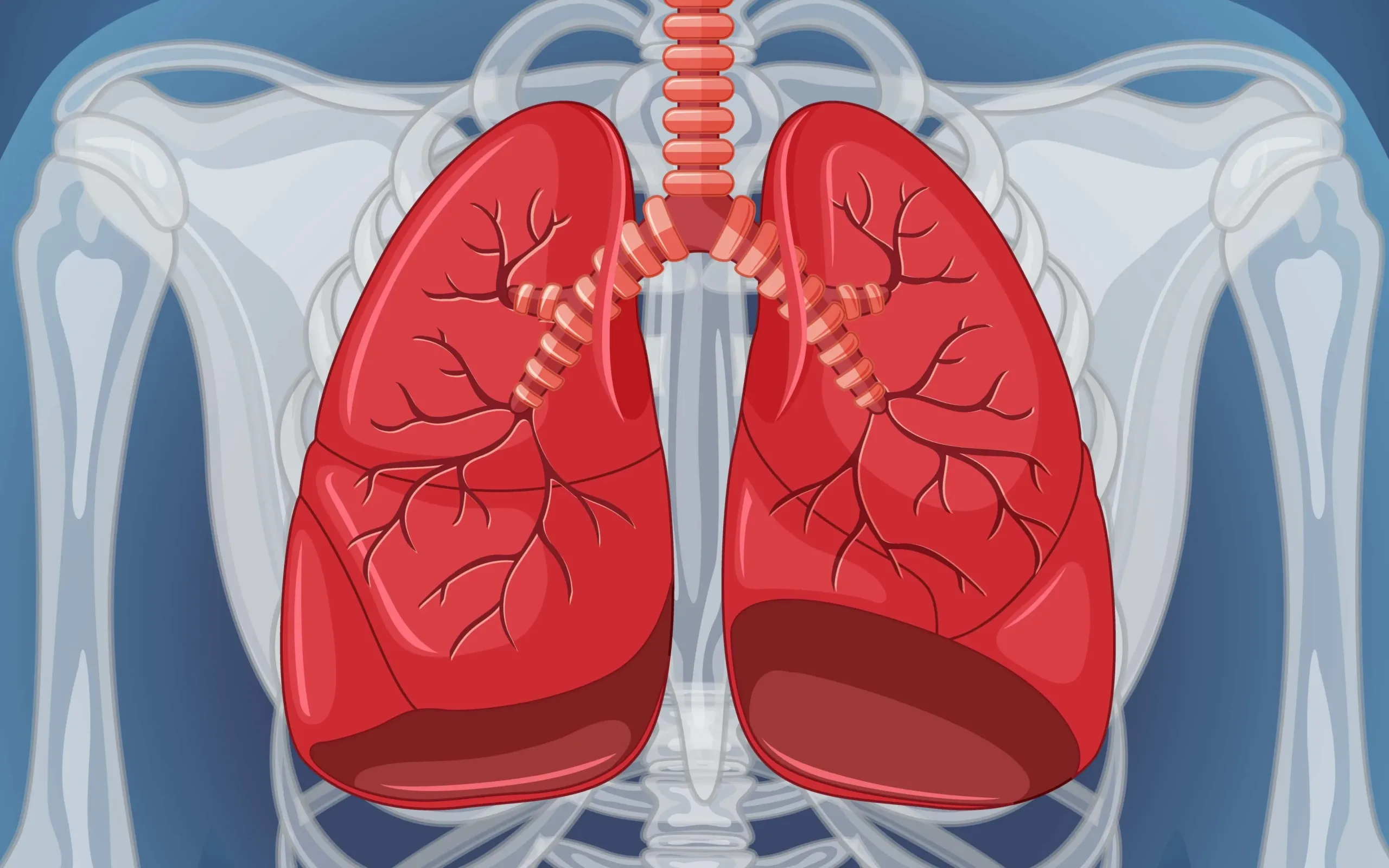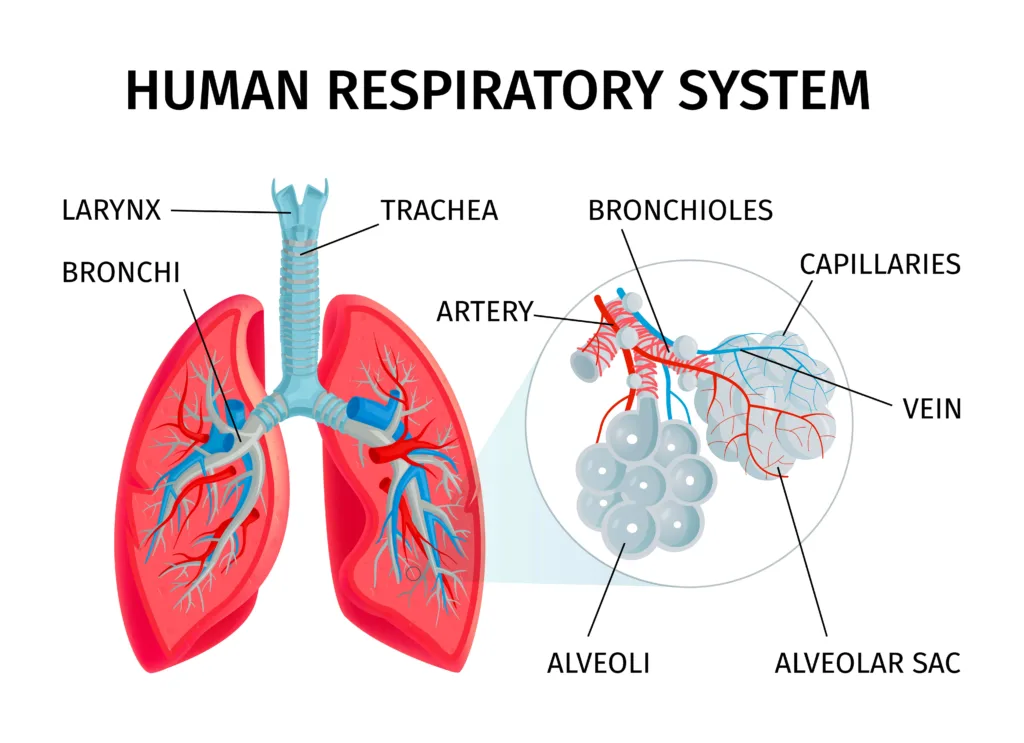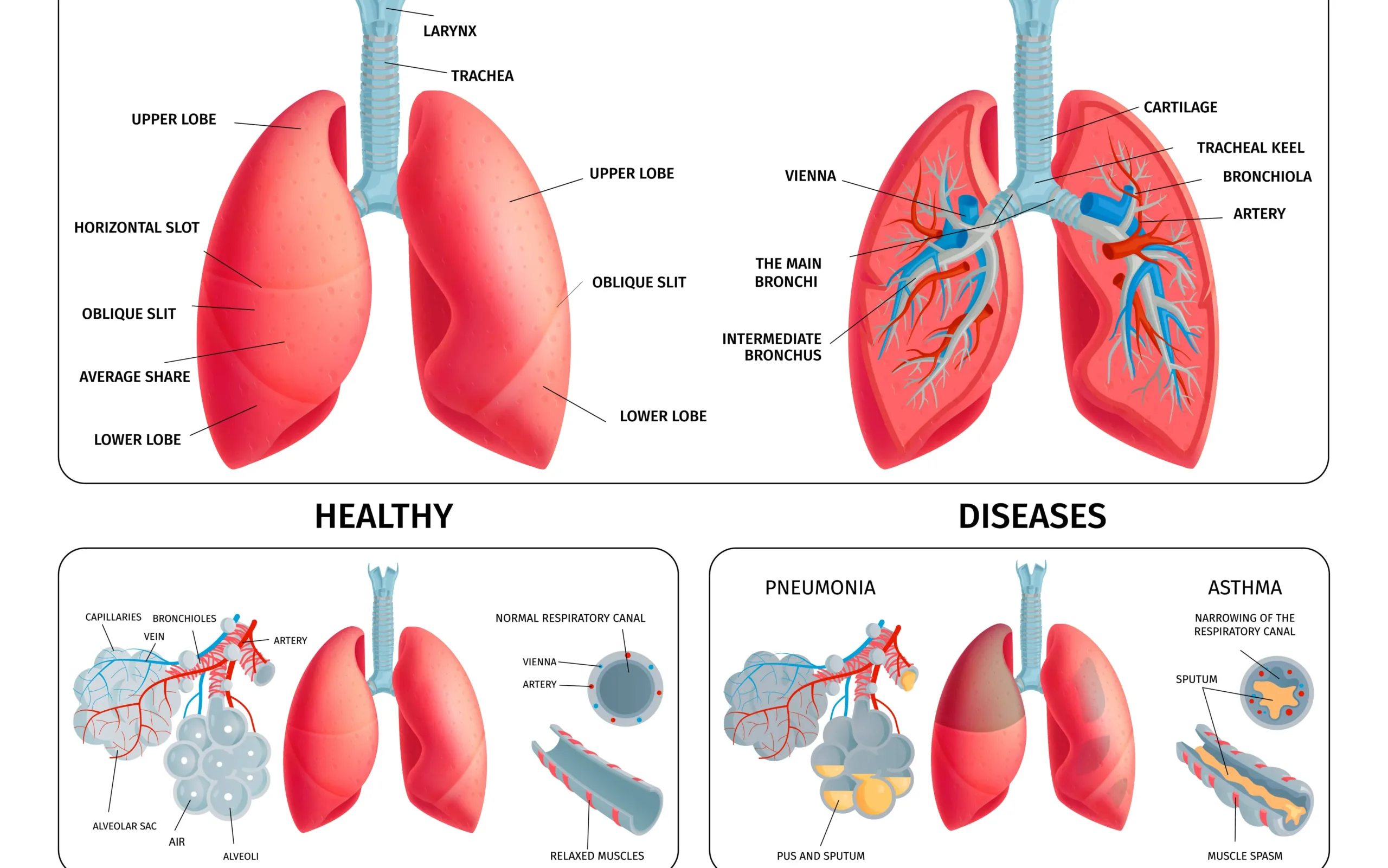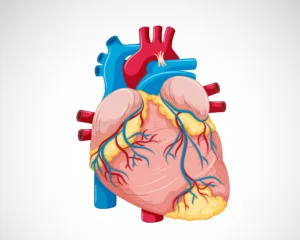Know all about Human Lungs, related diseases and its prevention.
Let’s first understand the human lungs, as per the human body structure, the lungs are the pair of spongy, air-filled organs located on either side of the chest. The trachea (windpipe) is responsible for inhaling the air into the lungs through its tubular branches, called bronchi. The bronchi then divide into smaller branches as can be seen in below pic.

The bronchioles (smaller branches) eventually end in clusters of microscopic air sacs called alveoli. In the alveoli, oxygen from the air is absorbed into the blood and the carbon dioxide, a waste product of metabolism is sent back from the blood to the alveoli, where it can be exhaled.
Now, there are many lung conditions which may gradually or rapidly damage the lungs. Let’s see some of the most common lung conditions.
Since, it is an important organ in the human body and plays an important role for removing carbon dioxide from the blood and adding oxygen to it. The heart and lungs work together to do this.
Now, let’s see about the parts of the respiratory system and how it works.

The bronchioles (smaller branches) eventually end in clusters of microscopic air sacs called alveoli. In the alveoli, oxygen from the air is absorbed into the blood and the carbon dioxide, a waste product of metabolism is sent back from the blood to the alveoli, where it can be exhaled. Also, there are ways to inhale and exhale the air from the body as follows.
AIRWAYS– The NOSE is the preferred entrance for outside air into the respiratory system.
MOUTH, Air also enters through the mouth especially for those who have a mouth-breathing habit, whose nasal passages may be temporarily blocked by a cold, or during heavy exercise.
The THROAT collects incoming air from your nose and mouth then passes it down to the windpipe (trachea).
The WINDPIPE (trachea) is the passage leading from your throat to your lungs.
Now, If someone experiences any of the below mentioned difficulty then that is a sign of warning. Hence, needs to be taken care of.
Shortness of Breath– This is not normal to experience the Shortness of breath if it is hard to breath.
Chronic Cough- If cough duration is more than eight weeks or longer is considered chronic and this is early symptom which shows there is some problem with respiratory system.
Chronic Mucus production– If mucus (sputum) is produced by airways as a defense against infections and if it last a month or longer then there is some problem with lungs.
Noisy breathing is a sign that something unusual is blocking nose.
Chronic chest pain– Chest pain that lasts for a month and may get worsen is also a warning sign.
now, based on the above symptoms, there are many lung conditions which may gradually or rapidly damage the lungs. Let’s see some of the most common lung conditions.
Pneumonia is one of the most common infection which may affect either of the lungs part or both the lungs. Bacteria, especially Streptococcus pneumonia and bacterial virus are the most common cause. To know more about pneumonia, click here.
Asthma, this is also one of most commonly find disease amongst all age groups as it is chronic. The lungs’ airways (bronchi) become inflamed and can spasm which causes shortness of breath and wheezing. Various allergies, viral infections and air pollutants often trigger asthma symptoms. To know more about Asthma, click here.

This is an infection of the lungs’ large airways (bronchi), usually caused by bacterial virus. Cough is the main symptom of acute bronchitis. To know more about Acute bronchitis, click here.
Obesity hypoventilation syndrome:
As name suggests, overweight makes it difficult to expand the chest when breathing. This can lead to long-term breathing problems. To know more about obesity hypoventilation syndrome, click here.
Pleural effusion:
This is called fluid, which builds up in the normally tiny space between the lung and the inside of the chest wall (the pleural space). If there is getting more building of pleural effusions can cause problems with breathing.
In Bronchiectasis, the airways (bronchi) become inflamed and expand abnormally, usually after repeated infections. Coughing, with large amounts of mucus, is the main symptom of bronchiectasis.
Lung Cancer is one of the most irreversible kinds of disease, which may affect almost any part of the lung. Most lung cancer is caused by smoking.
Acute respiratory distress syndrome (ARDS):
This is generally happens due to severe and sudden injury to the lungs which is caused by a serious illness. Life support with mechanical ventilation is usually needed to survive until the lungs fully recover.
There are many lungs test done to check and diagnose the lung problems.
Chest X-ray: An X-ray is the most common first test for lung problems. It can identify air or fluid in the chest, fluid in the lung, pneumonia, masses, foreign bodies, and other problems.
Computed tomography (CT scan): A CT scan uses X-rays and a computer to make detailed pictures of the lungs and nearby structures.
Pulmonary function tests (PFTs): A series of tests to evaluate how well the lungs work. Lung capacity, the ability to exhale forcefully, and the ability to transfer air between the lungs and blood are usually tested.
Lung biopsy: A small piece of tissue is taken from the lungs, either through bronchoscopy or surgery. Examining the biopsied tissue under a microscope can help diagnose lung conditions.
Flexible bronchoscopy: An endoscope (flexible tube with a lighted camera on its end) is passed through the nose or mouth into the airways (bronchi). A doctor can take biopsies or samples for culture during bronchoscopy.
Magnetic resonance imaging (MRI scan): An MRI scanner uses radio waves in a magnetic field to create high-resolution images of structures inside the chest. sample is usually examined to identify the cause.
Treatment
Antibiotics: Medicines that kill bacteria are used to treat most cases of pneumonia. Antibiotics are not effective against viruses.
Antiviral drugs: When used soon after flu symptoms start, antiviral medicines can reduce the severity of influenza. Antiviral drugs are not effective against viral bronchitis.
Bronchodilators: Inhaled medicines can help expand the airways (bronchi). This can reduce wheezing and shortness of breath in people with asthma or COPD.
Thoracotomy: A surgery that enters the chest wall (thorax). Thoracotomy may be done to treat some serious lung conditions or to obtain a lung biopsy.
Video-assisted thorascopic surgery (VATS): Less-invasive chest wall surgery using an endoscope (flexible tube with a camera on its end). VATS may be used to treat or diagnose various lung conditions.
Chest tube (thoracostomy): A tube is inserted through an incision in the chest wall in order to drain fluid or air from around the lung.
Pleurocentesis: A needle is placed into the chest cavity to drain fluid that’s around the lung. A sample is usually examined to identify the cause.

